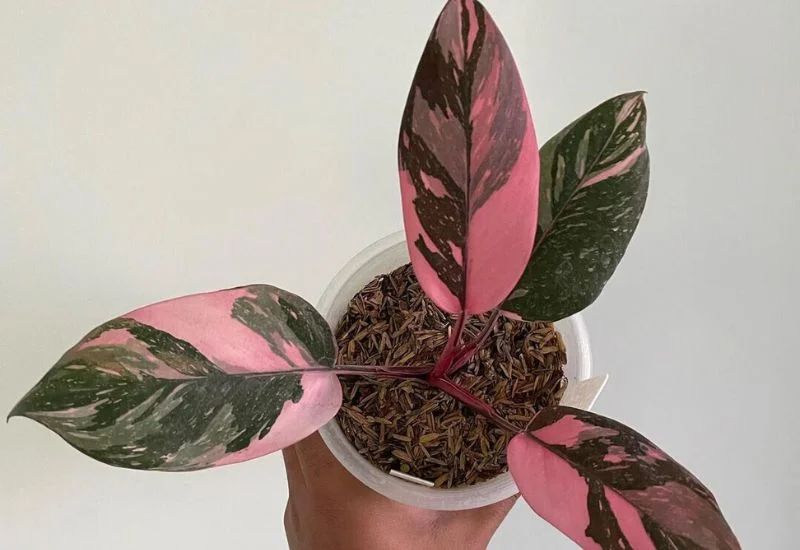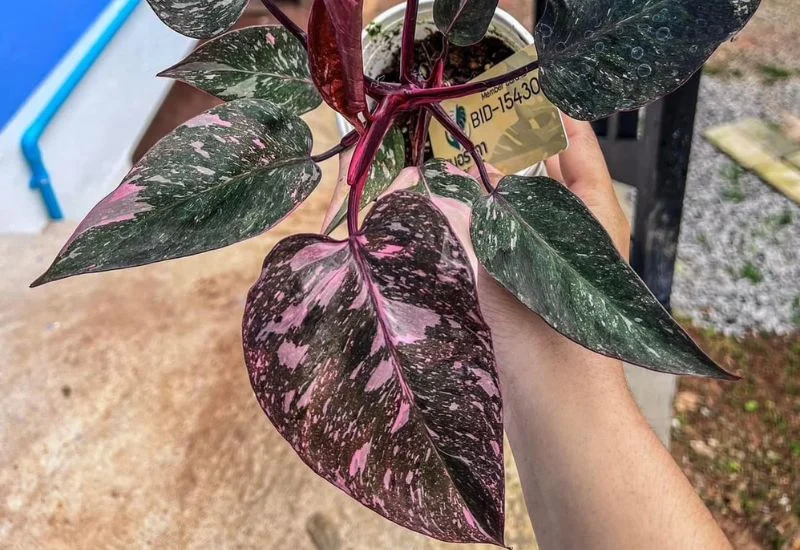In this blog post, you’re going to learn how to easily propagate and care for Philodendron Pink Princess Marble.
This is a comprehensive guide covering reliable information about different aspects of this variety.
In this post, I’ll cover:
- Interesting Facts
- Propagation
- Repotting
- Care
- Similar Plants
- Solutions to Common Problems
So, if you are looking to propagate and care for Philodendron Pink Princess Marble
, this guide is for you.
Let’s jump right in!
Fun Facts
| Common Name | Philodendron Pink Princess Marble Galaxy |
| Botanical Name | Philodendron erubescens |
| Family | Araceae |
| Plant Type | Perennial |
| Fruit | Yes |
| Mature Size | 4 feet long and 3 feet wide |
| Sun Exposure | Bright indirect light |
| Soil Type | Well-drained, moist soil |
| Soil pH | 5.5 to 6.5 |
| Native Area | South America |
| Toxic | Yes |
| Growth | Moderate to fast |
The pink princess marble philodendron is the perfect addition to a collection of any household plant. This plant prefers warm and humid areas. The philodendron growth is moderate to fast, which is perfect for filling and emphasizing space. The plant produces flowers with a spadix of yellow to cream color and a green color of spathe. This plant needs a perfect mimic of the natural environment to produce flowers.
The flowers further produce fruit. The fruit of the plant is berry, which contains seeds. The fruits are non-edible. Producing fruit for this plant indoors is very rare. The leaves of the plant come in a deep dark green background with marble variegation of pink and white splashes. The leaves are heart-shaped and grow up to 5 to 6 inches long. The plant is a climber. You can provide it with additional support.
Benefits

The plant brings several benefits. Here is the list:
Aesthetic Appeal
The plant is the best option to increase the esthetic of your home. It will enhance the beauty and become the center of attention in the room you place it. The plant is perfect for luxuriously decorating your home.
Air Purification
The plant absorbs the harmful chemicals from the air and makes the environment clean.
Mood Enhancement
The plant is excellent for enhancing mood. The watering and caring routine can distract you from your daily chores and provide you with a feeling of fulfillment.
Improves Humidity
Plants release water vapor during transpiration, which can increase the humidity level. It is moist and beneficial in the dry season. Increased humidity can prevent dry skin and soreness.
Promotes Learning and Responsibility
Taking care of a plant increases the sense of responsibility and offers a valuable educational experience.
Propagation
Pink princess marble philodendrons can be propagated through stem cutting. Take a healthy stem with at least 3 to 4 leaves. Remove the leaf just below the node. Place the cutting into the rooting hormone. This step is not important, but it will boost the growth of plants. Place the cutting into the jar of water. Change the water as needed to prevent bacterial infection. Place the jar in a humid and warm place. In a few weeks, the cutting will start developing roots. Once the roots are one inch long, place them into a pot filled with well-drained soil.
Repotting

The repotting of plants can be done in 2 to 3 years or when you see the roots of the plant are outgrown from the drainage hole of the pot. Repot the plant into a pot that is 3 to 4 inches bigger than the previous one. Add fresh soil and make sure the pothole is working perfectly.
Care
Here is the list of considerations you need to follow while caring for your plant:
Pruning
The pruning of the plant is essential to maintain its vibrancy. Only use sterilized equipment. Remove the yellow leaves of the plant. You can also cut the plant to maintain the desired shape and growth.
Soil
The plant prefers well-drained and moist soil to stay healthy. Choose the soil that is airy enough and can hold the needed moisture for the plant.
Pot
A pot made of ceramic or terracotta is recommended. These pots are good at absorbing excess moisture from the plant. You can also use a plastic-based pot that is lightweight but not durable. The plastic pot does not provide breathing space for the plant.
Water
Instead of following the watering routine, water the plant according to its preference. Let the top first inch of soil dry. Do not let the soil completely dry. You can check it with the help of your fingers. Water the plant and make sure there is not a lot of excess water that can lead to root rot.
Light
Like the other philodendrons, pink princess marble philodendrons need bright indirect light to thrive. The plant can survive in low light, but prolonged periods can reduce the pink variegation of the plant.
Fertilizer
The plant needs the fertilizer for its maximum growth. Use well-balanced liquid-based fertilizer. Do not apply the fertilizer directly to the roots; it can burn them. Water the plant first, then apply the fertilizer once a month.
Placement
The plant needs bright, indirect sunlight. Place it near the east-facing window, which is the perfect spot for indirect light, and it will save your plant from the direct light of the sun. If you do not have a good spot near a window, you can draw sheer curtains to block direct sunlight.
Temperature and humidity
The plant prefers a little warm temperature to live. The recommended temperature is 65 °F to 80 °F. Temperature below 60 °F can harm the health of plants. The plant enjoys more humid levels. You can increase the humidity by placing a humidifier or a pebble tray filled with water.
Common Problems

Here is the list of common problems that every plant faces:
Pests
Cause
The common pests are spider mites, mealybugs, scales, and fungus ants that start to live on your plant.
Solution
Regularly inspect your plant for any pests or bugs. Clean the leaves of the plant with a damp cloth. Apply neem oil to treat the infected area. You can also use a solution spray that will kill the insects.
Fungal Diseases
Here are some common fungal issues of pink princess marble philodendron:
Leaf spot
Cause
The reason can be low humidity and poor air circulation that made small spots on the leaves.
Solution
Remove the affected leaves to prevent the infection. Place the plant in a preferred humid area. You can also use fungus infection spray to treat the disease.
Root rot
Cause
The root rot leads to yellow leaves and an unpleasant smell in the soil. The reasons for this can be overwatering and less exposure to light.
Solution
Cut the affected parts of the roots to save the plant. Make sure the drainage hole is working and avoid overwatering; place your plant in bright, indirect sunlight.
Brown Tips
Cause
The reason can be low humidity or more use of fertilizers that lead to leaves turning brown.
Solution
You can place the humidifier near the plant to increase the humidity or place a tray filled with pebbles. Use the fertilizer for half of its strength only once a month. Do not apply the fertilizer in the season when the temperature starts to fall.
Curling Leaves
Cause
There can be several reasons for curling leaves. The underwatering of the plant can lead to curling leaves. Other reasons can be low humidity, excessive light, over-fertilization, pest infection, and temperature stress.
Solution
To prevent the problem, inspect the environment of the plant carefully to find the real culprit and take necessary actions.
Yellow leaves
Cause
There are various reasons for yellowing leaves. The main reason is overwatering; however, low nutrients and humidity can also contribute.
Solution
Before watering the plant, check if the soil is dry. Ensure the drainage hole of the pot is working properly. Check the humidity level near the plant and maintain it as needed.
Varieties & Similar Plants

Here is the list of similar plants of pink princess marble philodendron. The plant does not have any varieties:
Similar Plants
- Philodendron ‘Pink Princess‘
- Philodendron ‘White Knight’
- Philodendron ‘White Princess’
- Philodendron ‘White Wizard’
- Philodendron ‘Red Emerald’
- Philodendron ‘Brasil’
- Philodendron ‘McColley’s Finale’
Ready to Grab a Philodendron Pink Princess Marble to add beauty to your home garden?
All the above information is reliable, and you’ll see outstanding results if you want to grow or care for this plant.
